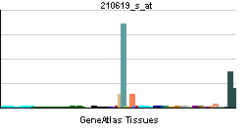HYAL1
| View/Edit Human | View/Edit Mouse |
Hyaluronidase-1 is an enzyme that in humans is encoded by the HYAL1 gene.[3][4][5]
This gene encodes a lysosomal hyaluronidase. Hyaluronidases intracellularly degrade hyaluronan, one of the major glycosaminoglycans of the extracellular matrix. Hyaluronan is thought to be involved in cell proliferation, migration and differentiation. This enzyme is active at an acidic pH and is the major hyaluronidase in plasma. Mutations in this gene are associated with mucopolysaccharidosis type IX, or hyaluronidase deficiency. The gene is one of several related genes in a region of chromosome 3p21.3 associated with tumor suppression. Multiple transcript variants encoding different isoforms have been found for this gene.[5]
See also
References
- ↑ "Human PubMed Reference:".
- ↑ "Mouse PubMed Reference:".
- ↑ Frost GI, Csoka AB, Wong T, Stern R (Aug 1997). "Purification, cloning, and expression of human plasma hyaluronidase". Biochem Biophys Res Commun. 236 (1): 10–5. doi:10.1006/bbrc.1997.6773. PMID 9223416.
- ↑ Csoka AB, Frost GI, Wong T, Stern R (Jan 1998). "Purification and microsequencing of hyaluronidase isozymes from human urine". FEBS Lett. 417 (3): 307–10. doi:10.1016/S0014-5793(97)01309-4. PMID 9409739.
- 1 2 "Entrez Gene: HYAL1 hyaluronoglucosaminidase 1".
Further reading
- Wei MH, Latif F, Bader S, et al. (1996). "Construction of a 600-kilobase cosmid clone contig and generation of a transcriptional map surrounding the lung cancer tumor suppressor gene (TSG) locus on human chromosome 3p21.3: progress toward the isolation of a lung cancer TSG.". Cancer Res. 56 (7): 1487–92. PMID 8603390.
- Natowicz MR, Short MP, Wang Y, et al. (1996). "Clinical and biochemical manifestations of hyaluronidase deficiency.". N. Engl. J. Med. 335 (14): 1029–33. doi:10.1056/NEJM199610033351405. PMID 8793927.
- Csóka AB, Frost GI, Heng HH, et al. (1998). "The hyaluronidase gene HYAL1 maps to chromosome 3p21.2-p21.3 in human and 9F1-F2 in mouse, a conserved candidate tumor suppressor locus.". Genomics. 48 (1): 63–70. doi:10.1006/geno.1997.5158. PMID 9503017.
- Triggs-Raine B, Salo TJ, Zhang H, et al. (1999). "Mutations in HYAL1, a member of a tandemly distributed multigene family encoding disparate hyaluronidase activities, cause a newly described lysosomal disorder, mucopolysaccharidosis IX.". Proc. Natl. Acad. Sci. U.S.A. 96 (11): 6296–300. doi:10.1073/pnas.96.11.6296. PMC 26875
 . PMID 10339581.
. PMID 10339581. - Frost GI, Mohapatra G, Wong TM, et al. (2000). "HYAL1LUCA-1, a candidate tumor suppressor gene on chromosome 3p21.3, is inactivated in head and neck squamous cell carcinomas by aberrant splicing of pre-mRNA.". Oncogene. 19 (7): 870–7. doi:10.1038/sj.onc.1203317. PMID 10702795.
- Shuttleworth TL, Wilson MD, Wicklow BA, et al. (2002). "Characterization of the murine hyaluronidase gene region reveals complex organization and cotranscription of Hyal1 with downstream genes, Fus2 and Hyal3.". J. Biol. Chem. 277 (25): 23008–18. doi:10.1074/jbc.M108991200. PMID 11929860.
- Lokeshwar VB, Schroeder GL, Carey RI, et al. (2002). "Regulation of hyaluronidase activity by alternative mRNA splicing.". J. Biol. Chem. 277 (37): 33654–63. doi:10.1074/jbc.M203821200. PMID 12084718.
- Strausberg RL, Feingold EA, Grouse LH, et al. (2003). "Generation and initial analysis of more than 15,000 full-length human and mouse cDNA sequences.". Proc. Natl. Acad. Sci. U.S.A. 99 (26): 16899–903. doi:10.1073/pnas.242603899. PMC 139241
 . PMID 12477932.
. PMID 12477932. - Junker N, Latini S, Petersen LN, Kristjansen PE (2003). "Expression and regulation patterns of hyaluronidases in small cell lung cancer and glioma lines.". Oncol. Rep. 10 (3): 609–16. doi:10.3892/or.10.3.609. PMID 12684632.
- Franzmann EJ, Schroeder GL, Goodwin WJ, et al. (2003). "Expression of tumor markers hyaluronic acid and hyaluronidase (HYAL1) in head and neck tumors.". Int. J. Cancer. 106 (3): 438–45. doi:10.1002/ijc.11252. PMID 12845686.
- Ota T, Suzuki Y, Nishikawa T, et al. (2004). "Complete sequencing and characterization of 21,243 full-length human cDNAs.". Nat. Genet. 36 (1): 40–5. doi:10.1038/ng1285. PMID 14702039.
- Gerhard DS, Wagner L, Feingold EA, et al. (2004). "The status, quality, and expansion of the NIH full-length cDNA project: the Mammalian Gene Collection (MGC).". Genome Res. 14 (10B): 2121–7. doi:10.1101/gr.2596504. PMC 528928
 . PMID 15489334.
. PMID 15489334. - Muzny DM, Scherer SE, Kaul R, et al. (2006). "The DNA sequence, annotation and analysis of human chromosome 3.". Nature. 440 (7088): 1194–8. doi:10.1038/nature04728. PMID 16641997.
- Christopoulos TA, Papageorgakopoulou N, Theocharis DA, et al. (2006). "Hyaluronidase and CD44 hyaluronan receptor expression in squamous cell laryngeal carcinoma.". Biochim. Biophys. Acta. 1760 (7): 1039–45. doi:10.1016/j.bbagen.2006.03.019. PMID 16713680.
- Lokeshwar VB, Estrella V, Lopez L, et al. (2007). "HYAL1-v1, an alternatively spliced variant of HYAL1 hyaluronidase: a negative regulator of bladder cancer.". Cancer Res. 66 (23): 11219–27. doi:10.1158/0008-5472.CAN-06-1121. PMID 17145867.
- Hofinger ES, Spickenreither M, Oschmann J, et al. (2007). "Recombinant human hyaluronidase Hyal-1: insect cells versus Escherichia coli as expression system and identification of low molecular weight inhibitors.". Glycobiology. 17 (4): 444–53. doi:10.1093/glycob/cwm003. PMID 17227790.
- Nieuwdorp M, Holleman F, de Groot E, et al. (2007). "Perturbation of hyaluronan metabolism predisposes patients with type 1 diabetes mellitus to atherosclerosis.". Diabetologia. 50 (6): 1288–93. doi:10.1007/s00125-007-0666-4. PMC 1914278
 . PMID 17415544.
. PMID 17415544. - Bharadwaj AG, Rector K, Simpson MA (2007). "Inducible hyaluronan production reveals differential effects on prostate tumor cell growth and tumor angiogenesis.". J. Biol. Chem. 282 (28): 20561–72. doi:10.1074/jbc.M702964200. PMID 17502371.
This article is issued from Wikipedia - version of the 5/31/2016. The text is available under the Creative Commons Attribution/Share Alike but additional terms may apply for the media files.
